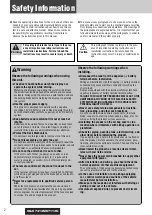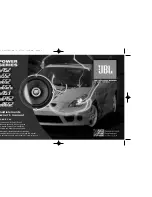
8
HORIZONTAL BI-AMPING: If two different stereo amps are available, one amp can drive
the woofers and the other amp, perhaps of lower power, can drive the M/T’s. This works well with
large solid state amps driving the woofers, with a smaller tube amp driving the upper end. We have
heard of systems with 200 watts per channel on the woofers, with 20-30 watts per channel of tube
power driving the M/T sections. This may seem like an imbalance, but since the most power is needed
to drive the woofers, it will work very well!
PLACEMENT
The VR-5 Anniversary are
Room Interactive
, meaning that they were designed to work in an average
listening room, not an anechoic chamber. Speakers that measure very good in an anechoic chamber
will usually sound too bass heavy and directional when placed in a room due to boundary effects and
room gain in the bass region. The increased bass response of the room (called boundary gain) has
been factored into the VR-5’s tonal balance, along with the reflective nature of boundary surfaces
such as wood, plaster, glass, and so forth. Since the VR-5’s are quasi-omnidirectional transducers,
designed to be the inverse of the recording microphone, their sound output will react with the
listening room in a positive manner
only if properly placed
. There are two components of sound
which reach the listener’s ears:
1. The direct arrival, or initial wave-launch of the speaker itself; this is the sound that is purely from
the speaker system and should be dominant in your room.
2. The secondary waves which are reflected from the room’s boundary surfaces. The reflected sound
is delayed according to the distances involved from the speaker to the boundaries, then back to the
listener. It is important for the reflected sound-field to integrate properly with the initial wave-launch,
since out-of-phase reflections will interfere with both flat frequency response and image focus. It is
not difficult to determine where the best placement will be in any given room, since you will be using
a pink noise listening test discussed later. (See Pink Noise Test on Page 8).
In every room, there will usually be more than one magic spot for the VR's to sound their best.
However, finding those spots is not intuitive due to the nature of reverberation characteristics and
room dimensions, which vary enormously from room to room. The VR's, being Virtual Reality
simulators, are designed to load the room very similarly to the way a live instrument would load the
room. Only in this way can your ear/brain hearing mechanism be lulled into believing that you
are
listening to an actual performance, and not simply “canned” sound. If you had a grand piano at the
end of the room where the speakers are playing, it would involve the entire room with semi-
omnidirectional sound, and your ear/brain hearing mechanism will clearly know this. The VR Virtual
Reality design will simulate this huge sound-field, with it’s involving depth and dimension. However,
correct placement is required to achieve the best possible sound quality. Amazingly, moving the
speaker only a few inches can make the difference between good sound and great sound due to the
reflective properties of your room! Note that this fact is true with most high quality speaker systems.
FOCAL POINT OF ARRAY:
The VR-5 is Time Aligned by use of mechanically displaced voice coils
achieved by the tilt-back M/T module and the specialized
Global Axis Integration Network
TM

































